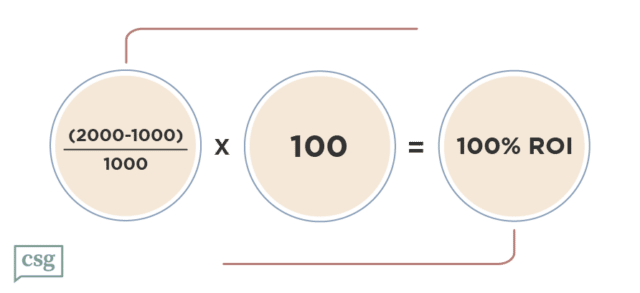What Is Content Marketing ROI?
It’s the age-old marketer’s conundrum: How do I know if my work is even doing anything? For business owners, who have to keep a firm grasp on revenue and costs, this is less an entertaining philosophical matter than a daily pain in the neck. As content marketing continues to overtake traditional methods of promoting goods and services, the difficulties in gauging marketing effectiveness assume new forms and demand new solutions.
If you spend a certain amount of money on content marketing, can you track the results to learn how successful, dollar for dollar, your efforts have been? Yes you can. The secret lies in formulas to find return on investment, or ROI.
ROI calculations are the way you make sure your marketing campaigns are bringing in more revenue than it costs to launch them. In 2021, some amount of content marketing is a must for your company, and that implies the additional task of checking whether campaigns are going well, going poorly, or sitting somewhere in between.
While there is no definitive threshold at which ROI for content you put out is satisfactory, in general the only rule, as you might expect, is to make more money than you spend. If your content marketing ROI exceeds the investment amount even by a small margin, it’s worthwhile to keep going, although with some tweaks that we’ll discuss later, you may improve your ROI.
How to Measure the Results of Content Marketing
You can find your content marketing ROI by taking the amount of money a piece of content brought in (the return), minus what it cost you to produce and publish the content (the investment), divided by the money it cost (the investment again), times 100 to reach a percentage. So, if a piece brought in $2,000 and cost $1,000, the calculation would look like this:

Again, as long as the ROI is positive, i.e., as long as your content is generating more money than it’s costing, your content marketing strategy is viable. However, this brings up other questions: how do you know how much revenue a piece of content is bringing in? And if your content ROI profit margin is slim, what can you do to improve it? The first step in answering both of those is collecting data about your business’s online presence.
6 Metrics for Finding & Improving the ROI on Content Marketing
Calculating, and improving, your content ROI will involve recording changes in key metrics. Working with all of these metrics at once would be a daunting prospect, and probably not an efficient use of your resources. Instead, you could pick a few that correspond to your particular business goals, and measure those. So, for example, if your goal for a marketing campaign is to ‘get more traffic on your website’, you could track things like SEO performance, website traffic and perhaps social media shares. If you’re disseminating content focused on ‘raising your lead quality’, you could watch your website’s bounce rate (the rate at which people immediately run away from your website once they find it) and the conversion rate of your leads (the fraction of leads that ultimately become sales).
Doing things this way gives you some assurance when you go to calculate your content marketing ROI. If you’re watching one or two specific metrics go up and down during a marketing campaign, you can be confident that you know what contribution individual pieces of content are making to revenue. This will help you arrive at an ROI figure that isn’t being influenced by factors tangential or irrelevant to your company’s needs.
With all that in mind, what are the metrics you can focus on to find and improve content ROI? There are as many of these metrics as you can dream up, and they go in and out of fashion depending on the circumstances of the moment, but some of the main ones marketers work with are these:
Social Media Engagement/Backlinks
Are people willing to share your content with those they know personally? Do they like and comment on it? Do other businesses or publications link to your content in their own material? These things can help you get a sense of the quality of the content you’re releasing, its value to potential customers, and in turn your content marketing ROI.
SEO Performance
This is a precursor to web traffic, and it tends to move together with ROI for content. Organic interest in your product or service is a lot easier to come by when you’re not relegated to the 12th page of Google.
Traffic
The amount of web traffic you’re generating is fundamental to calculating and improving content marketing ROI. How big is the pool of people you’re driving to your website? How many pairs of eyes can you draw to your content?
Onsite Engagement/Bounce Rate/Other User Behavior
Once people are on your website, how do they act? Do they leave quickly or linger? Leave comments or stay silent? View multiple pages or just one? Knowing their behavior can lead you toward more accurate content ROI findings and higher ROI.
Lead Quality
How serious are the leads you’re generating? Do they check out your related resources, ask questions of your sales force, and otherwise behave as if they actually intend to buy something? Do they in the end, in fact, convert to buyers? These are the questions that put the “R” in ROI.
Exposure and Authority
Well before anyone gets to the point of patronizing your company, they’ll need to see or hear about it. How many people are made aware of your existence? And do they view you as an authority in your field? Changes in these areas can point to problem spots or bright spots in your ROI for content; these metrics are always in the background and always worth considering.
Drive Content Marketing ROI with Us
We’re always up for a content marketing challenge. Get in touch with us to learn how your content marketing could go further and do more without breaking the bank.


